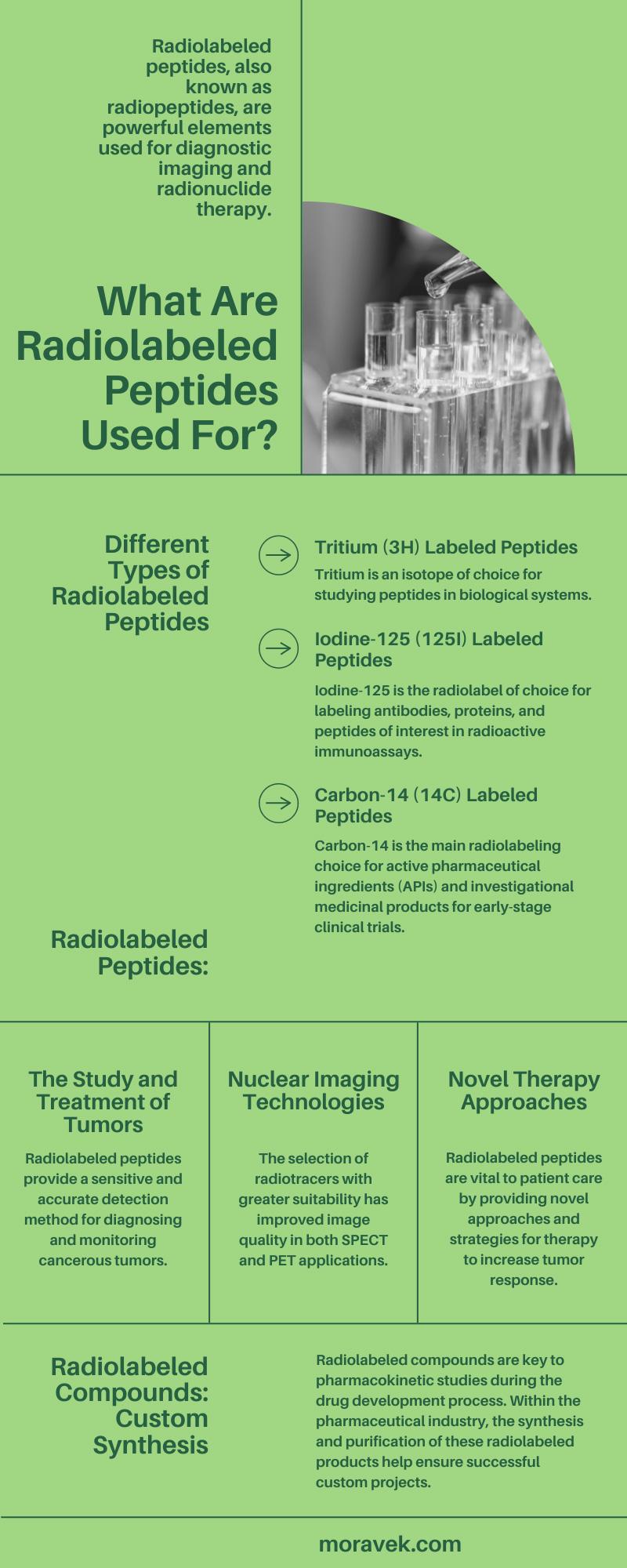
Modern scientists and scholars continually research and develop new innovative tools and materials for biomedical applications. One specific sector of science has proven itself to be integral: radiochemistry. This field of study generates life-changing revolutions in patient care and management. As a branch of radiology, nuclear medicine utilizes radiochemistry to develop radiolabeled compounds for clinical trials and settings.
Radionuclides—comprehensively known as radiotracers—are chemical compounds with nuclear properties. These substances help healthcare professionals classify, observe, and follow the behavior of various physical, chemical, or biological processes. Radioactive tracer technology further divides into sets of diverse classes. Radiolabeled peptides are a valuable subset of radiotracers, chemically modified to provide specified analytical methods in medical applications.
What are radiolabeled peptides used for? Radiolabeled peptides, also known as radiopeptides, are powerful elements used for diagnostic imaging and radionuclide therapy. The characterization of these laboratory-manufactured peptides is relatively new and complex as an up-to-the-minute expanding radiotracer group. For greater understanding, examine closer the following topics related to these synthesized compounds:
- The main types of radiolabeled peptides
- Tritium
- Iodine-125
- Carbon-14
- Radiolabeled peptide use in oncology
- Radiolabeled peptide use in imaging and diagnostics
- Radiolabeled peptide use in care and treatment
- Customized synthesis of radiolabeled compounds
Different Types of Radiolabeled Peptides
All living systems known today contain peptides as principal elements. These foundational rudiments are chains of amino acids responsible for numerous biological functions within the body. Every peptide has a specific bonding location within an organism. Due to their commonness in the body and their multi-functionality, peptides carry immense weight in the biomedical field.
These amino acid structures also possess a plethora of antimicrobial, antithrombotic, and antioxidant properties. Peptides and antibodies are fundamental components for medical application because of their innate properties. Peptides used for medical use are either naturally occurring or further synthetically modified variants that target biological activity. Radiolabeled peptides are the latter category that pertains to what exactly they are used for. These products serve as modified agents that enhance and improve medical techniques, procedures, and treatments.
Several types of radiolabeled peptides are common today for receptor, metabolic, and pharmacological studies: tritium, iodine-125, and carbon-14. The radiolabeling of peptides generally occurs via direct labeling or the multi-step incorporation of bonding molecules known as prosthetic groups. Chemists must identify a biologically stable position for the label to successfully characterize the product.
Tritium (3H) Labeled Peptides
Tritium is an isotope of choice for studying peptides in biological systems. This simple radiolabeled peptide is also a common choice for receptor studies. Chemists assemble, purify, and label these peptides with treated tritium gas for applicable use. Chemists can also increase the number of tritium atoms in a molecule to adjust to a specified activity. The use of tritium-labeled peptides is superior for lower concentration experimentation.
Iodine-125 (125I) Labeled Peptides
Iodine-125 has a relatively short half-life of 60 days, alongside low-energy photon emission detectable by gamma rays. Iodination adds the radiotracer to modify a peptide’s physical properties for specific activities. Iodine-125 is the radiolabel of choice for labeling antibodies, proteins, and peptides of interest in radioactive immunoassays.
Carbon-14 (14C) Labeled Peptides
Carbon-14 is the main radiolabeling choice for active pharmaceutical ingredients (APIs) and investigational medicinal products for early-stage clinical trials. In certain circumstances, this application includes the synthesis of carbon-14 labeled peptides for pharmacokinetics and receptor studies. Carbon-14 labeled peptides are usable in drug therapies, investigational medicines, and assay development. Peptides labeled with radioactive carbon are often tailor-made to the customer’s position requirements to adequately track the passage of the peptide through a biological system.
Radiolabeled Peptides: The Study and Treatment of Tumors
Radiolabeled peptides serve a vital role in oncology. The role of radiolabeled peptides in this field began with the introduction of the first radiopeptide in clinical settings several decades ago when coping with the rising of cancer cells. At this time, there was a need to develop tools to expand therapy options for tumors.
In recent years, exponential growth caused advanced development in utilizing these synthesized compounds as carrier molecules. Fresh and innovative techniques have created additional peptide-based radiopharmaceuticals within the comprehensive nuclear medicine field.
Nuclear medicine continues to offer possibilities for early cancer diagnosis through receptor-specific radiotracers. Radiolabeled peptides provide a sensitive and accurate detection method for diagnosing and monitoring cancerous tumors.
Radiolabeled Peptides: Nuclear Imaging Technologies
As a remarkable subject of research, recent and concentrated studies regarding radiolabeled peptides offer a unique perspective toward radionuclide imaging. These research and development efforts currently result in enhanced pharmacokinetics and state-of-the-art imaging, providing significant strategies for bettering patient care. More recently, the selection of radiotracers with greater suitability has improved image quality in both SPECT and PET applications.
SPECT and PET Imaging
Molecular imaging techniques utilize the characteristics of radiolabeled peptides for targeted detection and evaluation of numerous common cancers. Compared to healthy, normal cells, cancerous cells within the body overexpress their peptide receptors, creating molecular targets. Ergo, radiolabeled peptides are specific imaging probes to locate these molecular targets. A wide array of peptide-based radionuclides have been developed or are under clinical review for applicable diagnostic use for receptor imaging.
Within nuclear imaging, two different imaging methods can capture and screen these areas: single-photon emission computed tomography (SPECT) and positron emission tomography (PET). These innovative imaging techniques analyze biochemical or physiological changes within an organ or section of tissues. Through nuclear imaging, physicians and healthcare specialists can visualize, identify, and measure processes at both molecular and cellular levels.
Radiolabeled Peptides: Novel Therapy Approaches
Radiolabeled peptides are vital to patient care by providing novel approaches and strategies for therapy to increase tumor response. Throughout the years, developments in radionuclide therapy have occurred in the field, but one leading treatment is known as peptide receptor radionuclide therapy (PRRT). This site-directed target strategy lies between several medicinal disciplines, highlighting an example of how combined research studies and scientific projects create new technologies to ultimately change patient care for the better.
Radiolabeled Compounds: Custom Synthesis
Radiolabeled compounds such as radionuclides are the face of research and development within nuclear medicine. Radiolabeled compounds are key to pharmacokinetic studies during the drug development process. Within the pharmaceutical industry, the synthesis and purification of these radiolabeled products help ensure successful custom projects.
Contact us at Moravek for high-quality radiolabeling services. Moravek is a custom radiolabeling manufacturer providing comprehensive services for the synthesis, purification, and testing of active pharmaceutical ingredients. Moravek’s radiochemists complete custom synthesis with Tritium or Carbon-14. Our team of radiochemistry specialists produces radiolabeled compounds to meet the requirements of specific clinical studies or projects. Reach out with any questions concerning our company or services today.

